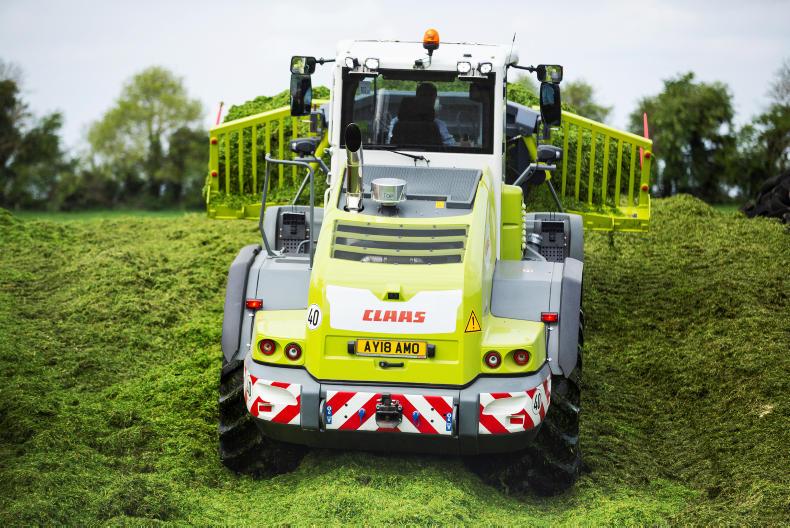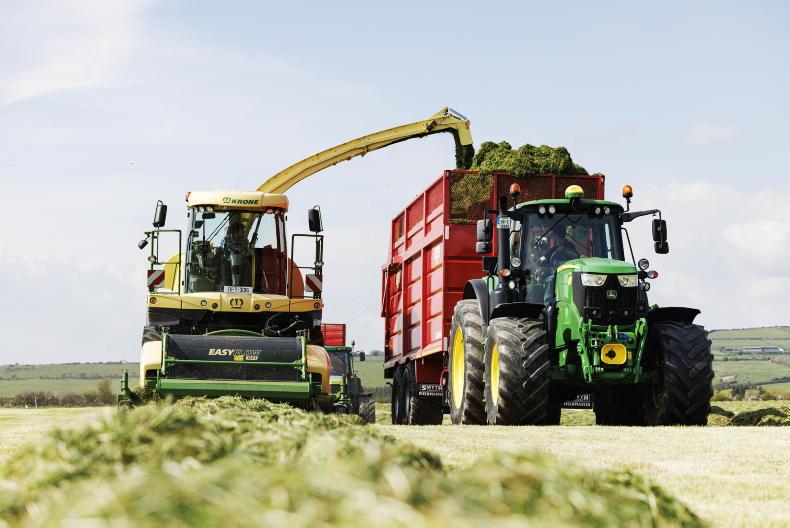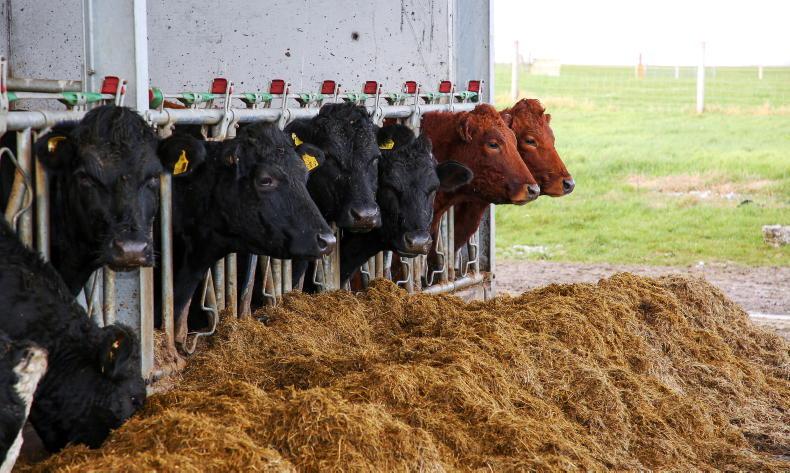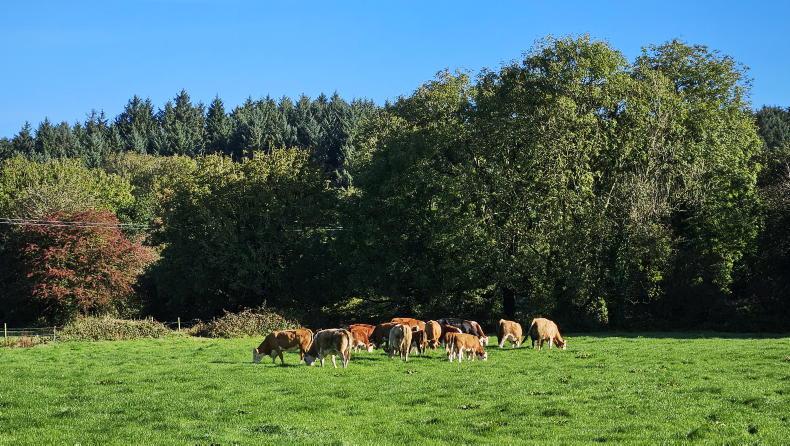In 2017, 30% of farm fatalities were caused by tractors or farm vehicles, with a further 20% caused by farm machinery. That means half of farm deaths were caused by vehicles and machinery combined. Teagasc health and safety specialist Dr John McNamara said the biggest safety considerations with farm vehicles are visibility and speed. “In terms of speed, a vehicle travelling at 8km/h is covering 2m every second,” he said. “That can be fatal in a lot of instances.”
With that in mind, visibility must be optimum on vehicles at all times. It goes without saying that all windows and glass should be in good repair and clean. One piece of technology being trialled in Teagasc Moorepark on an industrial loader is a 360° camera. Dr McNamara said: “There is a series of cameras placed on the machine giving a full 360° view. What is good about this particular camera is that it synthesises all surrounding images into one image. When the driver looks at the monitor in the vehicle, it gives one single image as if a camera was looking down from above the vehicle.” This equipment is expensive but worth a consideration on particularly big machines or in farmyards with multiple staff.
Calving is a stressful and tiring time of the year on many farms and a fatigued person is more at risk of being involved in an accident. In an effort to minimise time spent getting up during the night to monitor animals, equipment is available to assist farmers.
Cameras are becoming an integral part of monitoring cows during calving. Most of these are operated by WiFi and can be accessed with a smartphone. Cameras range from basic set-position cameras to 360° rotating cameras. 
Moocall calving sensor
Another good piece of technology is the MooCall calving sensor. This tail-mounted piece of technology can monitor contractions in cows and heifers, enabling it to send an SMS to farmers an hour before active calving. This can help to prevent unnecessary trips to the calving shed in the middle of the night and ensure a longer night’s sleep.
A final piece of equipment directly linked to safety is the Mandown, a system that is being used in Teagasc Grange during calving season. The Mandown is a monitor attached to personnel attending cows during calving. The system, linked to Grange’s overall security system, will send an alert once a person is immobile for over three minutes, suggesting something might have happened.
Slurry presents two health and safety threats – drowning and gas poisoning. Drowning is by far the most common cause of death involving slurry but gas poisoning from hydrogen sulphide also plays a big part. This gas has a rotten-egg smell at low levels but is odourless at higher levels. Dr McNamara of Teagasc said that while slurry gas monitors are available, they are not fully recommended. “Even a small level of gas can cause unconsciousness and a lung-full will certainly cause death,” he said. “The problem with monitors is it can often be too late by the time they alert you of the risk.”
Dr McNamara said the key factors for slurry safety are to only agitate on a windy day and never go into a slurry tank. He added: “Perhaps the best piece of technology of all for slurry safety would be a wind speed monitor. Air needs to be circulating and a good gauge of the wind speed will certainly be a worthwhile piece of information.”

One simple piece of technology is a motion sensor or timer connected to the main yard light.
Adequate lighting in a yard is something that a lot of farms fall down on. With calving or lambing taking place on many farms in the spring, doing night-time monitoring in the dark is a bad idea. A lot of accidents can happen simply in search of a light switch in a shed or on a wall so getting your electrician to put one light on a motion sensor or timer can be extremely helpful.
In 2017, 30% of farm fatalities were caused by tractors or farm vehicles, with a further 20% caused by farm machinery. That means half of farm deaths were caused by vehicles and machinery combined. Teagasc health and safety specialist Dr John McNamara said the biggest safety considerations with farm vehicles are visibility and speed. “In terms of speed, a vehicle travelling at 8km/h is covering 2m every second,” he said. “That can be fatal in a lot of instances.”
With that in mind, visibility must be optimum on vehicles at all times. It goes without saying that all windows and glass should be in good repair and clean. One piece of technology being trialled in Teagasc Moorepark on an industrial loader is a 360° camera. Dr McNamara said: “There is a series of cameras placed on the machine giving a full 360° view. What is good about this particular camera is that it synthesises all surrounding images into one image. When the driver looks at the monitor in the vehicle, it gives one single image as if a camera was looking down from above the vehicle.” This equipment is expensive but worth a consideration on particularly big machines or in farmyards with multiple staff.
Calving is a stressful and tiring time of the year on many farms and a fatigued person is more at risk of being involved in an accident. In an effort to minimise time spent getting up during the night to monitor animals, equipment is available to assist farmers.
Cameras are becoming an integral part of monitoring cows during calving. Most of these are operated by WiFi and can be accessed with a smartphone. Cameras range from basic set-position cameras to 360° rotating cameras. 
Moocall calving sensor
Another good piece of technology is the MooCall calving sensor. This tail-mounted piece of technology can monitor contractions in cows and heifers, enabling it to send an SMS to farmers an hour before active calving. This can help to prevent unnecessary trips to the calving shed in the middle of the night and ensure a longer night’s sleep.
A final piece of equipment directly linked to safety is the Mandown, a system that is being used in Teagasc Grange during calving season. The Mandown is a monitor attached to personnel attending cows during calving. The system, linked to Grange’s overall security system, will send an alert once a person is immobile for over three minutes, suggesting something might have happened.
Slurry presents two health and safety threats – drowning and gas poisoning. Drowning is by far the most common cause of death involving slurry but gas poisoning from hydrogen sulphide also plays a big part. This gas has a rotten-egg smell at low levels but is odourless at higher levels. Dr McNamara of Teagasc said that while slurry gas monitors are available, they are not fully recommended. “Even a small level of gas can cause unconsciousness and a lung-full will certainly cause death,” he said. “The problem with monitors is it can often be too late by the time they alert you of the risk.”
Dr McNamara said the key factors for slurry safety are to only agitate on a windy day and never go into a slurry tank. He added: “Perhaps the best piece of technology of all for slurry safety would be a wind speed monitor. Air needs to be circulating and a good gauge of the wind speed will certainly be a worthwhile piece of information.”

One simple piece of technology is a motion sensor or timer connected to the main yard light.
Adequate lighting in a yard is something that a lot of farms fall down on. With calving or lambing taking place on many farms in the spring, doing night-time monitoring in the dark is a bad idea. A lot of accidents can happen simply in search of a light switch in a shed or on a wall so getting your electrician to put one light on a motion sensor or timer can be extremely helpful.












SHARING OPTIONS